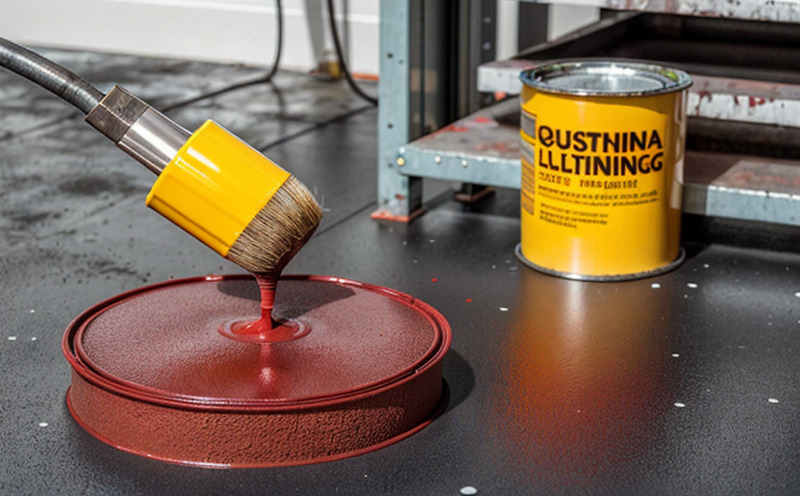EN 13823 Reaction to Fire Testing of Paint Systems
The EN 13823 standard is a critical tool for testing the reaction to fire performance of paint systems used in industrial manufacturing and processing. This test evaluates how well a paint system resists ignition, spreads of flame, and heat release during exposure to flames or other sources of fire. Understanding this is essential for ensuring safety standards are met and that materials perform reliably under extreme conditions.
The standard applies specifically to paint systems intended for use in industrial facilities where fire resistance is paramount. This can include environments such as chemical processing plants, refineries, and power generation sites, among others. The test assesses the behavior of these paints when exposed to flames, simulating real-world scenarios like accidental ignition or mechanical failure.
The testing process involves subjecting a specimen cut from the paint system under controlled conditions to an open flame. Observations are made on how quickly the paint ignites, its resistance to spreading flames, and the amount of heat it releases during combustion. The results provide valuable insights into the fire performance characteristics of the paint system.
The test is not only a compliance requirement but also serves as a tool for quality assurance and continuous improvement in product development. By understanding how well their products perform under these stringent conditions, manufacturers can refine formulations to achieve better fire resistance properties without compromising on other essential qualities like adhesion or flexibility.
For industrial facilities, adopting EN 13823 ensures compliance with international safety regulations while also enhancing the overall reliability and longevity of infrastructure. It plays a crucial role in protecting workers from potential hazards associated with flammable materials and supports efforts towards more sustainable practices by promoting safer alternatives for use across various industries.
Why It Matters
The importance of adhering to EN 13823 cannot be overstated, particularly in high-risk industrial sectors where safety is non-negotiable. Reactivity to fire tests help identify potential risks early on by simulating conditions that could lead to catastrophic failures if left unaddressed. By identifying weak points within a paint system's design or manufacturing process, manufacturers can take corrective actions before they become critical issues.
Incorporating these tests into the production cycle also fosters innovation and competitiveness among businesses operating in this field. It encourages continuous improvement through research and development aimed at creating next-generation fire-resistant coatings that meet both current standards and future expectations set by evolving technologies and regulatory frameworks.
From a broader societal perspective, implementing robust fire safety measures like those outlined in EN 13823 contributes significantly to public health and environmental sustainability. By minimizing the risk of fires spreading rapidly through industrial complexes or other critical facilities, we protect human lives while reducing the likelihood of extensive property damage.
Ultimately, compliance with this standard reflects a commitment to excellence in product quality and operational safety. It demonstrates that your organization prioritizes not just meeting legal requirements but exceeding them where necessary – thereby setting a benchmark for best practices within your industry.
Customer Impact and Satisfaction
- Better Safety: Ensures that industrial facilities comply with strict fire safety regulations, reducing the risk of accidents and injuries.
- Enhanced Reputation: Demonstrates a commitment to quality and sustainability, which can significantly enhance your brand's reputation among stakeholders.
- Increased Confidence: Provides customers peace of mind knowing that their facilities meet or exceed international standards for fire resistance.
- Competitive Advantage: In an increasingly globalized market, being able to demonstrate compliance with international standards can set you apart from competitors who may not offer equivalent levels of assurance.
By investing in EN 13823-compliant testing services, your organization shows its commitment to excellence and reliability. This dedication translates directly into higher customer satisfaction rates and stronger relationships built on trust.
Use Cases and Application Examples
| Application Example | Description |
|---|---|
| Chemical Processing Plant: | Paint systems used inside pipelines transporting highly flammable liquids need to withstand intense heat and flames without contributing to fire spread. |
| Power Generation Facility: | Paint coatings on structural steel components must maintain integrity during unexpected fires caused by equipment malfunctions or natural disasters. |
| Petrochemical Plant: | Incorporating fire-resistant paint onto containment vessels reduces the risk of catastrophic explosions resulting from ignition sources within the facility. |
| Refinery Complex: | Using EN 13823-compliant paints on external walls helps protect against accidental fires originating from nearby construction sites or vehicles. |
In each of these scenarios, proper implementation and adherence to EN 13823 ensures that the chosen paint systems perform reliably under extreme conditions, thereby safeguarding lives and property alike. These tests are an integral part of ensuring that industrial facilities meet stringent safety requirements.





